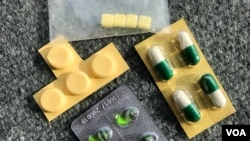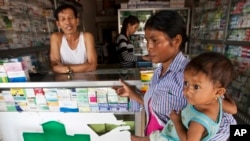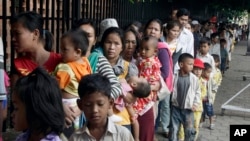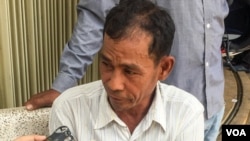Srey Leak had a cold, so she did what many Cambodians do when they get sniffly and sneezy: She went to a pharmacy near her home in the capital’s Kandal Market neighborhood and asked for “healing medicine,” the generic Khmer-language term for antibiotics.
Within a few minutes, a pharmacist had handed her a colorful cocktail of pills in a plastic baggie—none of which could be identified because they were tablets doled out from larger containers.
For this, Leak, 29, paid about $2 and received no information about what she was about to ingest. Still, she said she was satisfied.
“I don’t know what the side effects are, and I never ask about that,” she said as she held her 3-month-old in a carrier strapped to her chest.
This method of drug dispensation is very common in Cambodia, where many aspects of the health-care system go almost entirely unregulated.
But it's also a dangerous practice—and one that is getting riskier by the day. Due in large part to antibiotic misuse, drug-resistant bacteria have emerged in recent years as one of the world’s biggest public health risks. And developing countries such as Cambodia are at the forefront of the problem.
A Double-Edged Medical Sword
Antibiotics are vital tools for killing bacteria and have saved millions of lives since they were first introduced in the 1940s. But used improperly, they can sow the seeds of their own destruction. Bacteria exposed to small amounts of antibiotics often evolve to resist the drug’s mechanism of action, becoming stronger and stronger.
This evolution can be spurred by taking the wrong antibiotic, failing to finish a full course of antibiotics, or taking an antibiotic when it is not necessary—for example, to treat a cold, which is caused by a virus and not a bacterium. All three of these practices are widespread in Cambodia.
Cambodia was one of the first countries in the region to develop a policy on antimicrobial resistance, or AMR, in 2014. Guided by the World Health Organization, the policy was comprehensive and included a three-year plan for implementation. But this has still not translated to action, several experts on the topic said.
A key plank of the policy was a 2016 directive ordering pharmacists to stop dispensing antibiotics without a doctor’s prescription. But a Health Ministry spokesman told VOA Khmer he had no idea whether any pharmacy had ever been disciplined for doing so.
A doctor who has worked closely with the government on its response to drug resistance, speaking on condition of anonymity because he was not authorized to talk to the media, said there would be no progress on fighting antibiotic resistance without enforcement.
“In Singapore, you can’t buy antibiotics because they are not OTC [over the counter] drugs,” he said. “It's only sold with a prescription. But we can buy them in our country. This is the problem. It is a crisis for the future.”
Om Chhorvoin, a researcher who co-authored a 2017 paper on antibiotic misuse in Cambodia, said the ministry’s ban was being totally ignored by pharmacists, who saw it as non-binding because there was nobody monitoring their dispensation of antibiotics.
He compared the government’s AMR policy to a blueprint for a house drawn up by a good architect. Although the plans are solid, nothing has actually been built.
“Today we have regulations and laws, but they are not put into practice in reality,” said Chhorvoin. “The authorities seem incapable of ensuring that the ministry’s regulations are obeyed.
Passing the Buck
Dressed in a doctor’s gown, Keo Lyhour was busy one recent morning doling out baggies of medicine to his customers at Phsar Tapang, a well-known cluster of pharmacies near Phnom Penh’s Central Market.
He said more and more people have been coming to him and asking specifically for antibiotics—and he is happy to oblige.
“We don’t really tell them about the side effects. If we tell them a lot of side effects, the buyer will lose confidence in the drugs,” Lyhour said.
Luong Sophoat, a pharmacist at the new Western-style chain Help Plus Pharmacy, told VOA she knew antibiotic resistance was a serious issue and tried to comply with government guidelines.
However, she said she had only been informed of these rules once and was under the impression they were non-binding.
“The proper way to use antibiotics is with appropriate prescription and diagnosis from the doctor,” said Sophoat, who recalled the new rules from a pharmacists’ meeting in Phnom Penh, which took place “one or two years ago, I cannot remember,” she said.
But she said in the absence of enforcement, there was serious business pressure for pharmacies to continue selling antibiotics.
“Most of the people who come here say that mostly they use this drug from other pharmacies and they want to continue using it,” she said. “This puts pressure on pharmacists.”
Nine pharmacists interviewed by VOA said they had not received any printed government guidelines from the Ministry of Health. All of them said they were unsure whether it was legal or illegal to sell antibiotics without a doctor’s prescription.
Dr. Ly Sovann, a spokesman for the Ministry of Health and president of the ministry’s AMR Technical Working Group, told VOA in an interview that the ministry had made its rules, and now it was up to pharmacies to comply.
“If our officials find any pharmacies which do not comply with our regulations, the pharmacists will face legal punishment,” he said. “This includes confiscation of their license.”
However, when asked whether any pharmacies had ever been punished for selling antibiotics without a prescription, Dr. Sovann said he did not know. He claimed the situation was better than before but had no data he could share on the issue. Instead, he suggested that journalists call a Health Ministry hotline.
“We have done our job,” he said of the government. “What’s next is cooperation from the people, and from journalists too. If you all see wrongdoing, you can report it to our hotline.”
The Faster, the Better?
VOA journalists visited three different pharmacies in different parts of Phnom Penh and asked for medicine to treat a common cold—for which antibiotics are unnecessary.
Without asking for a doctor’s prescription, the pharmacists all quickly handed back small plastic baggies filled with a colorful medley of pills.
Two of them had dispensed cephalosporin, a strong antibiotic that should only be taken for relatively rare infections.
VOA reporters also asked the pharmacists whether there were antibiotics in the bags, and what the proper duration of treatment was.
The pharmacists all reacted with surprise at being questioned. One of them said it was “okay” to take antibiotics for two days.
“But if you have more money you should buy more, probably for three days,” he said.
This is a common experience at Cambodian pharmacies, where patients are rarely given clear information on how to take medication properly.
According to Chhorvoin’s 2017 paper, “Pervasive Antibiotic Misuse in the Cambodian Community,” antibiotics are widely distributed in urban and rural areas alike by everyone from nurses to unofficial village doctors known as "pett phum," who often have only piecemeal medical training, sometimes dating back to the Khmer Rouge era.
Chhorvoin and his co-authors found that these "pett phum" practitioners often doled out strong antibiotics such as fluoroquinolones and cephalosporins for no good reason.
They met Cambodian villagers so familiar with antibiotics that they would request them from local medics using nicknames: “pen” (penicillin), “amox” (amoxicillin), “ampi” (ampicillin), “tetra” (tetracycline), and “cotrim” (co-cotrimoxazole).
Many believed that antibiotics should be taken for every health problem, including vague inflammatory symptoms that had not been diagnosed.
“Ampi and amox help us, for example, when I have a stuffy nose, it helps to reduce the clogging,” one villager told the researchers.
The problem is not just with "pett phum," but extends all the way up to properly certified doctors, who often do not bother running tests to confirm that an illness is really bacterial, Chhorvoin told VOA.
“A lot of doctors with 20 or 30 years of experience in healthcare do not normally take biomedical labs seriously, as they are supposed to,” he said. “They are likely to prescribe antibiotics quickly because it saves them time.”
Many Cambodians also believe that “healing medicine,” as antibiotics are known here, is simply a substance that cures faster and more effectively than other drugs.
Because of this, 70-year-old Heng Sam Ang said she always stops taking antibiotics as soon as she feels better.
She said her local pharmacist in Phnom Penh had advised her that “too much medicine” was not healthy, and that stopping antibiotics quickly was a good idea.
“So, when I have a cold, sore throat, or a headache, I take amoxicillin. One or two pills is enough to fully recover. I don’t like to use a lot of meds,” she said, gripping a plastic baggie full of antibiotics she had just purchased from a pharmacy.
In fact, this contravenes all guidelines for the use of antibiotics. Patients are supposed to complete a full course of pills, and should never stop as soon as they feel better. Doing this creates a fertile breeding ground for antibiotic resistance, because the weaker bacteria die quickly, while the hardier ones can survive and multiply.
Part of a Global Problem
This careless use of antibiotics is contributing to a global crisis of antimicrobial resistance. An estimated 700,000 people die every year due to antibiotic-resistant infections, and the World Health Organization (WHO) projects that this will rise to 10 million deaths per year by 2050.
Poor and incomplete data means that the scope of resistance in Cambodia is still unclear, and a new government-run surveillance effort has still not collected its first round of data. However, individual studies and anecdotal evidence make it obvious that the problem is serious.
In 2011, over 10 percent of all tuberculosis cases in Cambodia were found to be resistant to multiple antibiotics, up from just 3.1 percent in 2001. A small follow-up study in 2015 called urgently for the resumption of national-level surveillance of drug-resistant tuberculosis, which showed signs of spreading in the population.
A 10-year study at the Angkor Hospital for Children in Siem Reap, which ran from 2007 to 2016 and had its results published in May, found that 82 percent of E. coli and K. pneumoniae samples at the hospital were resistant to multiple drugs.
The Institut Pasteur du Cambodge has also sounded an alarm, noting in a recent statement that it was detecting alarmingly high levels of resistance in several types of bacteria.
Over a four-year period starting in 2012, it found that the frequency of enterobacteria that produced extended-spectrum beta-lactamases (ESBLs), which give bacteria resistant to many types of antibiotics, increased from 23.8 percent to 38.4 percent in the samples it tested
Most startlingly, as many as 80 percents of pregnant women and 42 percent of infants tested by the Institut hosted enterobacteria that produced ESBLs, compared to less than 5 percent in Europe.
“The increase of these resistant bacteria can lead to a therapeutic impasse,” said Institut Pasteur biologist Alexandra Kerleguer in a statement.
Dr. Kerleguer said that when she first arrived in Phnom Penh, she was shocked to see how much more serious antimicrobial resistance was in Cambodia than in her home country, France.
Dr. Phe Thong of the Sihanouk Hospital Center of HOPE in Phnom Penh told VOA that in the past several years, he had seen a number of patients with alarming drug-resistant bacterial infections.
In some cases, they were resistant to all drugs available in the country. Dr. Thong said he had never encountered a serious case of antibiotic resistance before 2013.
Diseases like pneumonia and typhoid are especially hard to cure in Cambodia at the moment because the bacteria that cause them are highly resistant to existing antibiotics like ciprofloxacin and fluoroquinolone, Dr. Thong said.
This would be daunting for doctors anywhere. But the problem is compounded in Cambodia, where third-line antibiotics are often unavailable or prohibitively expensive. They also require patients to adhere to a much more rigorous treatment protocol, usually while hospitalized. And there is always the risk that bacteria will also evolve resistance to the strongest drugs, making them impossible to fight.
“Here, we experienced a few very serious cases in which the bacteria resist all the existing antibiotics in the country,” he said. “We were struggling to decide on the medication because we don't seem to have [antibiotics] to cure those patients.
Information Desperately Needed
Every study of antibiotic resistance in Cambodia has emphasized that a comprehensive national-level surveillance system is urgently needed. But getting it up and running has been slow going.
The Sihanouk Center, along with three other hospitals in Phnom Penh and four in provincial areas, are now enrolled in a World Health Organization program to track and fight resistance.
Although the program has existed for years, Cambodia only began collecting data in January 2018. There are still only eight hospitals in the country with the facilities to conduct the necessary tests for resistant bacteria, underscoring the depth of the challenges here.
The doctor who works on AMR issues said that without clear statistics on the scope of resistance, it has been impossible to create a national plan to control it.
“We don’t have any guidelines at all now. It is taking a long time because we don’t have any data to make them. We can’t have [guidelines] until we can get good enough data,” he said.
“Sweden leads this initiative, the WHO endorses the program, and the US’ Centers for Disease Control supports the government with resources, but I think it is up to the government, which must work harder itself,” the doctor added.
Dr. Thong agreed that senior leaders and doctors must change their behavior before patients can be expected to.
“Of course every country faces this issue, but only those countries with proper control, guidelines and regulations on antibiotic use will be able to lower resistance levels,” he said.
Until then, pett phum will keep doling out “healing medicine,” people across the country will keep taking them unquestioningly, and bacteria will keep on evolving drug resistance inside the bodies of Cambodians.
San Ros, 51, lives in a village in Kampong Cham and always takes the medicines his village doctor tells him to. He said usually he does not know what they are, and sometimes they have no effect on his symptoms, but he just hopes for the best.
“I always seek help from the pett phum,” he said. “When I tell them my symptoms—for example when I catch a cold—they give me some meds. Sometimes it cures the illness, but sometimes it doesn’t cure the illness, but this is normal. I don’t know. I just take it.”
Ngan Panha of Cambodian Youth Network (CYN) contributed to this report










